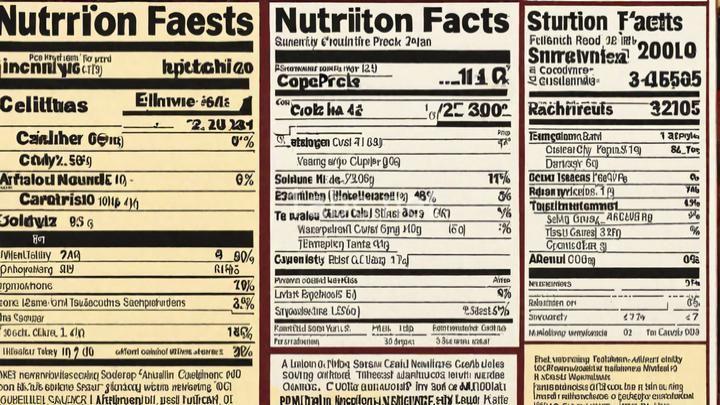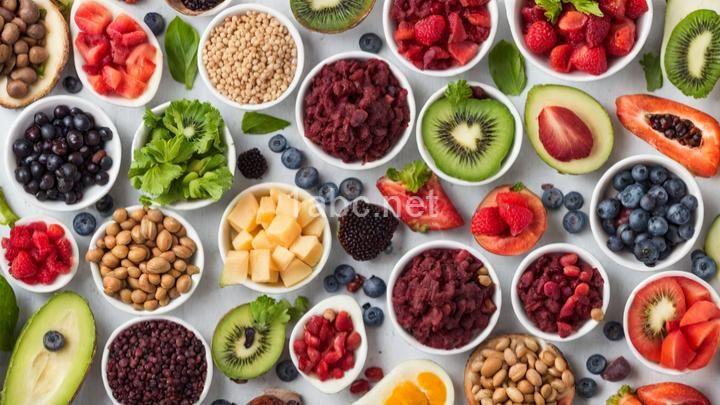Hidden Culprits: Uncovering Sneaky Ingredients in Food Labels

Introduction:
Have you ever wondered what goes into the food products you consume? As consumers, we often take for granted the ingredients that make up the food we eat. However, understanding what goes into our food is crucial for maintaining a healthy lifestyle. Reading and understanding food labels is essential for making informed decisions about our health. In this blog post, we will dive deep into the world of food labels and uncover the hidden culprits that may be lurking in our favorite foods.
I. Understanding Food Labels:
Food labels are the window into the world of packaged foods. They provide us with important information about the nutritional content and ingredients of a product. The purpose of food labels is to help consumers make informed choices about the food they purchase and consume. When it comes to food labels, it's important to look beyond the flashy marketing claims and focus on the details.
Every food label contains mandatory information that is regulated by government agencies. This information includes the nutritional facts, which provide details about the calories, fat, sugar, and other nutrients in the product. The ingredient list is another crucial component of food labels. It lists all the ingredients used in the product, from the most abundant to the least. Understanding how to read and decode these labels is the first step in uncovering the hidden culprits in our food.
II. Common Hidden Culprits:
a. Artificial Sweeteners:
Artificial sweeteners are a common hidden culprit in many food products. They are often used as a substitute for sugar to lower the calorie content of the product. However, artificial sweeteners have been linked to various health concerns, including digestive issues and an increased risk of obesity. Some common artificial sweeteners to be aware of include aspartame, sucralose, and saccharin.
b. Hidden Sugars:
Sugar is another hidden culprit that often goes unnoticed in food products. While we are familiar with the term "sugar," it can be disguised under various names on ingredient lists. High fructose corn syrup, cane juice, and maltose are just a few examples of hidden sugars that may be lurking in our favorite foods. Consuming excessive amounts of sugar can lead to weight gain, diabetes, and other health issues.
c. Hydrogenated Oils:
Hydrogenated oils, also known as trans fats, are commonly found in processed foods. These oils are created through a process called hydrogenation, which turns liquid oils into solid fats. Hydrogenated oils have been shown to increase bad cholesterol levels and contribute to heart disease. It's important to be mindful of these hidden culprits and opt for foods that are free from hydrogenated oils.
d. Hidden Sodium:
Sodium is an essential mineral that our bodies need in small amounts. However, consuming too much sodium can lead to high blood pressure and other health problems. Hidden sources of sodium can be found in processed foods, such as canned soups, frozen meals, and snacks. It's important to read food labels and choose low-sodium options whenever possible.
III. Sneaky Marketing Tactics:
Food companies often employ deceptive tactics to make unhealthy products appear healthier. One common tactic is the use of buzzwords like "natural," "organic," or "low-fat." These terms can be misleading and create a false sense of healthiness. For example, a product labeled as "natural" may still contain artificial additives or high amounts of sugar. It's important to look beyond these marketing claims and focus on the actual ingredients listed on the label.
Front-of-package claims are another sneaky marketing tactic used by food companies. These claims are often placed in bold letters and are designed to catch the consumer's attention. However, they may distract consumers from reading the actual ingredients and nutritional facts. It's important to read the entire food label and not rely solely on front-of-package claims when making purchasing decisions.
IV. Tips for Deciphering Food Labels:
Deciphering food labels can be a daunting task, but with a few practical tips, it becomes easier to make informed choices about the food we consume:
a. Start with the ingredient list: The ingredient list is where you'll find the truth about what goes into the product. Look for simple and recognizable ingredients, and be wary of long lists with unfamiliar names.
b. Prioritize whole foods: When possible, choose whole foods over processed ones. Whole foods are less likely to contain hidden culprits and provide more nutritional value.
c. Research unfamiliar ingredients: If you come across an ingredient that you're unfamiliar with, take the time to research it using reliable sources or smartphone apps. This will help you make informed decisions about whether or not to consume the product.
V. Making Informed Choices:
Empowering ourselves to make informed choices about the food we consume is essential for our health and well-being. By being more conscious of what we buy and consume, we can take control of our nutritional intake. Cooking homemade meals using fresh ingredients is a great way to ensure that we know exactly what goes into our food. Additionally, there are resources available that can help us find healthier alternatives to commonly consumed processed foods.
Conclusion:
Understanding food labels is key to making healthier choices and taking control of our well-being. By uncovering the hidden culprits in our food, we can make more informed decisions about what we consume. Remember, it's not about being perfect, but rather making small changes that add up over time. Let's continue to be curious and aware of the ingredients in our food, so that we can nourish our bodies and live healthier lives.
FREQUENTLY ASKED QUESTIONS
What is Hidden Culprits: Uncovering Sneaky Ingredients in Food Labels?
Hidden Culprits: Uncovering Sneaky Ingredients in Food Labels is a comprehensive guide that sheds light on the often overlooked ingredients lurking in our food. In this eye-opening content, we delve into the deceptive practices employed by food manufacturers and reveal the hidden culprits that may be compromising our health.Food labels can be misleading, with many products boasting claims of being "all-natural" or "organic." However, beneath these seemingly wholesome labels, there may be a host of sneaky ingredients that can have detrimental effects on our well-being.
The content explores common additives, preservatives, flavor enhancers, and sweeteners that are often added to processed foods. We discuss the potential health risks associated with these ingredients, such as allergic reactions, digestive issues, and even long-term health complications.
To assist you in making informed choices, we provide tips and strategies for deciphering food labels and identifying these hidden culprits. We emphasize the importance of reading ingredient lists carefully and understanding the various names and aliases that certain additives may have. By doing so, you can take control of your dietary choices and prioritize your health.
Our aim is to empower you with knowledge and equip you with the tools needed to navigate the aisles of the grocery store with confidence. By uncovering these sneaky ingredients and understanding their potential impact, you can make more mindful decisions about the foods you consume.
So, if you're ready to embark on a journey of uncovering the truth behind food labels, Hidden Culprits: Uncovering Sneaky Ingredients in Food Labels is here to guide you. Let's unveil the hidden secrets and reclaim control over what we put into our bodies.
Why should I be concerned about hidden ingredients in food labels?
Hidden ingredients in food labels can be a cause for concern, and here's why:Firstly, hidden ingredients refer to substances that may not be explicitly listed on the label but are still present in the food product. These ingredients can include additives, preservatives, artificial colors, flavors, and even allergens. Being aware of these hidden ingredients is crucial, especially if you have specific dietary requirements or allergies.
Secondly, hidden ingredients can have potential health implications. For example, some additives and preservatives have been linked to adverse health effects, such as allergic reactions, digestive issues, or even long-term health problems. By being conscious of hidden ingredients, you can make informed choices about the foods you consume and better manage your health.
Thirdly, hidden ingredients can also impact the nutritional value of the food. Some food products might claim to be "healthy" or "natural" on the front label but contain hidden ingredients that contradict those claims. By carefully reading food labels and understanding what ingredients are present, you can make healthier choices and ensure that you're getting the nutrients you need.
Lastly, hidden ingredients can be a concern for those who follow specific dietary lifestyles or have ethical considerations. For example, if you're vegetarian or vegan, hidden animal-derived ingredients, such as gelatin or certain food colorings, may go against your dietary choices. By being vigilant about hidden ingredients, you can align your food choices with your personal values.
In conclusion, being concerned about hidden ingredients in food labels is important for several reasons. It allows you to make informed choices about your health, manage dietary restrictions or allergies, maintain a specific dietary lifestyle, and ensure that the food you consume aligns with your values. By taking the time to read and understand food labels, you can be more confident in the products you choose to consume.
How can I identify hidden ingredients in food labels?
To identify hidden ingredients in food labels, there are a few key strategies you can employ. First and foremost, it's essential to carefully read the ingredient list. Look out for any unfamiliar or hard-to-pronounce ingredients, as these could be hidden additives or preservatives. Additionally, keep an eye out for common allergens such as nuts, dairy, gluten, or soy, especially if you have any food sensitivities or allergies.Another useful tactic is to pay attention to the order in which ingredients are listed. Ingredients are listed in descending order by weight, so if a potentially harmful ingredient is towards the top of the list, it may be present in significant amounts. On the other hand, if an ingredient is listed towards the end, it is likely present in smaller quantities.
If you come across any vague or ambiguous terms in the ingredient list, don't hesitate to do some research. The internet can be a valuable resource for uncovering hidden ingredients. You can also reach out to the manufacturer directly for clarification if needed.
Lastly, consider using smartphone apps or online databases that provide information on food additives and their potential health effects. These tools can help you identify hidden ingredients and make more informed choices about the foods you consume.
By employing these strategies, you'll be better equipped to identify hidden ingredients in food labels and make healthier decisions for yourself.
Are there specific ingredients I should watch out for?
When it comes to skincare products, it's always a good idea to be mindful of the ingredients. While everyone's skin is different, there are certain ingredients that can be potentially irritating or harmful for some individuals. Here are a few ingredients to watch out for:
-
Fragrance: Synthetic fragrances can be a common irritant and may cause allergic reactions. Opt for products that are fragrance-free or have natural fragrances.
-
Parabens: These are preservatives commonly used in skincare products. Some studies suggest that parabens may disrupt hormone function. Look for products labeled "paraben-free" if you prefer to avoid them.
-
Sulfates: Sulfates are surfactants that create lather in cleansers. They can be drying and irritating for some people, especially those with sensitive skin. Consider sulfate-free alternatives for a gentler cleanse.
-
Alcohol: Some alcohols, like ethanol and denatured alcohol, can be drying and irritating. Look for products that use fatty alcohols (such as cetyl alcohol or stearyl alcohol) which are less likely to cause dryness.
-
Synthetic dyes: Artificial dyes can also be potential irritants for some individuals. Opt for products that are dye-free or use natural colorants.
Remember, everyone's skin is unique, and what works for one person may not work for another. If you have specific concerns or sensitivities, it's always a good idea to consult with a dermatologist or conduct patch tests before incorporating new products into your skincare routine.



